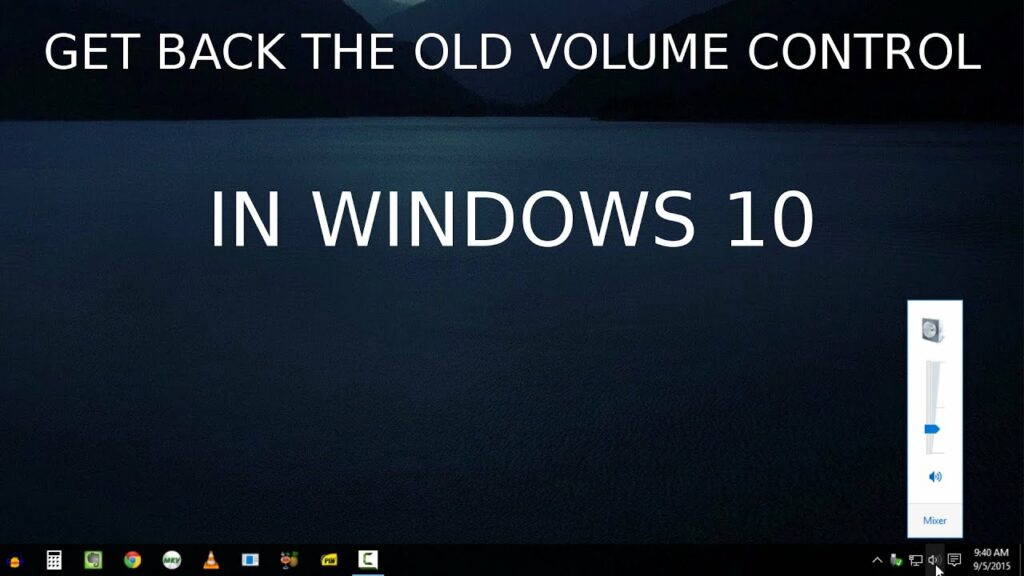Rediscovering Familiarity: A Comprehensive Guide on How to Get the Old Volume Control Back in Windows 10

I
ntroduction:
Windows 10, with its continuous updates and feature enhancements, occasionally introduces changes to the user interface, leaving some users longing for the familiar aspects of earlier versions. One notable change that has garnered attention is the revamped volume control interface. For those who miss the simplicity and functionality of the old volume control, this comprehensive guide provides step-by-step instructions on how to bring it back to Windows 10, offering a nostalgic touch and a return to a more familiar user experience.
Understanding the Old vs. New Volume Control:
- Classic Volume Control:
- In earlier versions of Windows, including Windows 7, the volume control was represented by a small speaker icon in the taskbar. Clicking on it opened a compact vertical slider, allowing users to adjust the volume quickly and efficiently.
- Modern Volume Flyout:
- Windows 10 introduced a modern volume flyout with a horizontal slider, accompanied by a larger interface that displays the volume level along with media playback controls. While this design is visually appealing, some users prefer the simplicity of the classic volume control.
Step-by-Step Guide to Get the Old Volume Control Back:
- Accessing Settings:
- Click on the Start menu, and select “Settings” (the gear icon). Alternatively, use the keyboard shortcut “Windows key + I” to open the Settings app.
- Navigating to Personalization:
- Within Settings, click on “Personalization.” This section encompasses various customization options for the Windows interface.
- Choosing Taskbar:
- In the left sidebar, select “Taskbar.” This opens the Taskbar settings, where users can modify various aspects of the taskbar, including the volume control.
- Adjusting Taskbar Settings:
- Scroll down to the “Notification area” section and click on “Turn system icons on or off.” This leads to a screen where users can customize which system icons are displayed in the taskbar.
- Enabling Volume Control:
- Locate the “Volume” option and toggle the switch to enable it. This ensures that the volume icon appears in the taskbar.
- Configuring Volume Icon Behavior:
- Click on the “Volume” text below the toggle switch to access additional settings related to the volume icon. Here, users can choose how the icon behaves, whether it shows only the volume icon, the icon and the percentage, or whether it’s hidden.
- Using the Classic Volume Control:
- Once the volume icon is enabled in the taskbar, users can simply click on it to reveal the classic vertical slider, reminiscent of earlier Windows versions. Adjusting the slider directly modifies the system volume.
Advanced Customization Options:
- Third-Party Tools:
- For users who desire more extensive customization options, third-party tools and applications are available. These tools often provide additional features, allowing users to tailor the appearance and functionality of the volume control to their preferences.
- Registry Edits:
- Knowledgeable users may choose to explore registry edits to further customize the volume control. However, it’s important to approach registry edits with caution, as they involve modifying critical system settings and can potentially lead to issues if not done correctly.
Benefits of Using the Old Volume Control:
- Simplicity and Familiarity:
- The classic volume control offers a straightforward and familiar interface. For users accustomed to earlier versions of Windows, this brings a sense of nostalgia and simplicity to the overall user experience.
- Efficiency in Volume Adjustment:
- The vertical slider of the classic volume control allows for quick and precise adjustments. Users who prefer a no-frills approach to volume control find the classic interface more efficient and responsive.
- Reduced Visual Clutter:
- The classic volume control takes up less space and reduces visual clutter in the taskbar. This can be particularly advantageous for users who prefer a more minimalistic and streamlined desktop environment.
Conclusion:
While Windows 10 continues to evolve with each update, the desire for familiar interfaces remains a common sentiment among users. The process of bringing back the old volume control is a straightforward customization that caters to those who appreciate the simplicity and efficiency of the classic design.
By following the step-by-step guide or exploring advanced customization options, users can tailor their Windows 10 experience to align with their preferences. The benefits of using the old volume control extend beyond mere aesthetics; they contribute to a personalized and nostalgic computing environment, providing users with a sense of familiarity in the ever-evolving landscape of operating systems.







